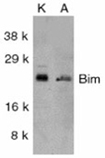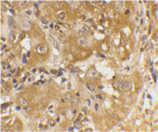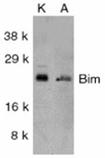Product Details
| Alternative Name: | BimEL, BimL, BCL2-like |
| |
| Host: | Rabbit |
| |
| Immunogen: | Synthetic peptide corresponding to the sequence near the middle of human Bim/BOD. |
| |
| UniProt ID: | O43521 |
| |
| GenBank ID: | AF032457, AF032458 |
| |
| Species reactivity: | Human, Mouse, Rat
|
| |
| Applications: | IHC, WB
|
| |
| Recommended Dilutions/Conditions: | Immunohistochemistry (20µg/ml)
Western Blot (1µg/ml, colorimetric)
Suggested dilutions/conditions may not be available for all applications.
Optimal conditions must be determined individually for each application. |
| |
| Application Notes: | Detects a band of ~23kDa by Western blot. |
| |
| Purity Detail: | Peptide affinity purified. |
| |
| Formulation: | Liquid. In PBS containing 0.02% sodium azide. |
| |
| Shipping: | Blue Ice |
| |
| Long Term Storage: | -20°C |
| |
| Scientific Background: | Bim/BOD is a group of three splice variants, BimEL, BimL, and BimS, with apparent molecular masses of ~23, 16, and 13 kDa, respectively. Bim is a critical regulator of lymphocyte homeostasis, acts as a barrier against autoimmune disease and is necessary for the apoptotic response to certain stress signals. All isoforms of Bim contain the C-terminal Bcl-2 homology domain known as BH3. Certain apoptotic stimuli release Bim from the complex which allows it to translocate to the mitochondria and bind to Bcl-2 or its homologues, thereby promoting apoptosis. |
| |
| Regulatory Status: | RUO - Research Use Only |
| |

Western blot analysis of human K562 cell lysate probed with Bim/BOD, pAb.

Immunohistochemistry analysis of Bim in human skin cancer cells with Bim antibody at 20µg/ml.
Please mouse over
Product Literature References
BCL-XL is crucial for progression through the adenoma-to-carcinoma sequence of colorectal cancer: P. Ramesh, et al.; Cell Death Differ.
28, 3282 (2021),
Abstract;
MARCH5-dependent degradation of MCL1/NOXA complexes defines susceptibility to antimitotic drug treatment: M.D. Haschka, et al.; Cell Death Differ.
27, 2297 (2020),
Abstract;
Full Text
Subtle Changes in the Levels of BCL-2 Proteins Cause Severe Craniofacial Abnormalities: S. Grabow, et al.; Cell Rep.
24, 3285 (2018),
Abstract;
HSPB1 facilitates ERK-mediated phosphorylation and degradation of BIM to attenuate endoplasmic reticulum stress-induced apoptosis: D. Kennedy, et al.; Cell Death Dis.
8, e3026 (2017),
Abstract;
Full Text
Antigen-affinity controls pre-germinal centser B cell selection by promoting Mcl-1 induction through BAFF receptor signaling: F.M. Wensveen, et al.; Sci. Rep.
6, 35673 (2016),
Application(s): Immunoblot, mouse cells,
Abstract;
Full Text
Interaction of ARC and Daxx: A Novel Endogenous Target to Preserve Motor Function and Cell Loss after Focal Brain Ischemia in Mice: S. Donath, et al.; J. Neurosci.
36, 8132 (2016),
Application(s): Immunoblotting and immunoprecipitation,
Abstract;
Full Text
An Inducible Lentiviral Guide RNA Platform Enables the Identification of Tumor-Essential Genes and Tumor-Promoting Mutations In Vivo: B.J. Aubrey, et al.; Cell Rep.
10, 1422 (2015),
Application(s): Western Blotting,
Abstract;
Y Nerve growth factor blocks thapsigargin-induced apoptosis at the level of the mitochondrion via regulation of Bim: A. Samali, et al. ; J. Cell. Mol. Med.
12, 2482 (2008),
Application(s): WB using rat cell lysates,
Abstract;
An inhibitor of c-Jun NH2-terminal kinase, SP600125, protects mice from D-galactosamine/lipopolysaccharide-induced hepatic failure by modulating BH3-only proteins: M. Takamura, et al. ; Life Sci.
80, 1335 (2007),
Application(s): WB using mouse tissue,
Abstract;
TRAIL/bortezomib cotreatment is potentially hepatotoxic but induces cancer-specific apoptosis within a therapeutic window: R. Koschny, et al.; Hepatology
45, 649 (2007),
Abstract;
Induction of SM-20 in PC12 cells leads to increased cytochrome c levels, accumulation of cytochrome c in the cytosol, and caspase-dependent cell death: R.S. Freeman, et al. ; J. Neurochem.
85, 318 (2003),
Application(s): WB using rat samples,
Abstract;
Induction of BIM, a proapoptotic BH3-only BCL-2 family member, is critical for neuronal apoptosis: E.M. Johnson, et al. ; Neuron
29, 615 (2001),
Application(s): WB using human samples,
Abstract;












